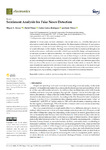Sentiment Analysis for Fake News Detection

Use este enlace para citar
http://hdl.handle.net/2183/28168
Excepto si se señala otra cosa, la licencia del ítem se describe como Atribución 4.0 Internacional (CC BY 4.0)
Colecciones
- Investigación (FFIL) [879]
Metadatos
Mostrar el registro completo del ítemTítulo
Sentiment Analysis for Fake News DetectionFecha
2021Cita bibliográfica
Alonso, M.A.; Vilares, D.; Gómez-Rodríguez, C.; Vilares, J. Sentiment Analysis for Fake News Detection. Electronics 2021, 10, 1348. https://doi.org/10.3390/electronics 10111348
Resumen
[Abstract] In recent years, we have witnessed a rise in fake news, i.e., provably false pieces of information created with the intention of deception. The dissemination of this type of news poses a serious threat to cohesion and social well-being, since it fosters political polarization and the distrust of people with respect to their leaders. The huge amount of news that is disseminated through social media makes manual verification unfeasible, which has promoted the design and implementation of automatic systems for fake news detection. The creators of fake news use various stylistic tricks to promote the success of their creations, with one of them being to excite the sentiments of the recipients. This has led to sentiment analysis, the part of text analytics in charge of determining the polarity and strength of sentiments expressed in a text, to be used in fake news detection approaches, either as a basis of the system or as a complementary element. In this article, we study the different
uses of sentiment analysis in the detection of fake news, with a discussion of the most relevant elements and shortcomings, and the requirements that should be met in the near future, such as multilingualism, explainability, mitigation of biases, or treatment of multimedia elements.
Palabras clave
Sentiment analysis
Opinion mining
Fake news
Social media
Opinion mining
Fake news
Social media
Versión del editor
Derechos
Atribución 4.0 Internacional (CC BY 4.0)
ISSN
2079-9292






